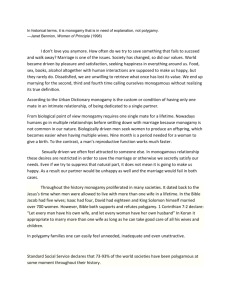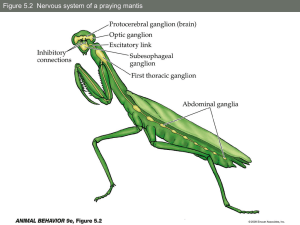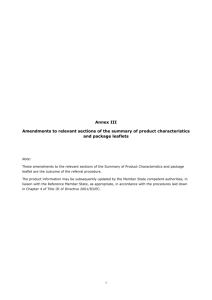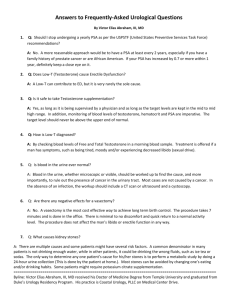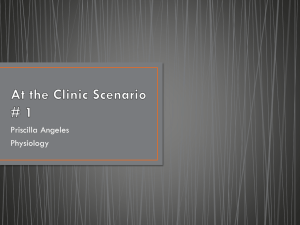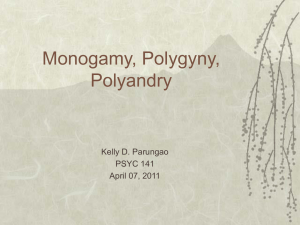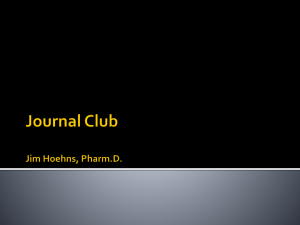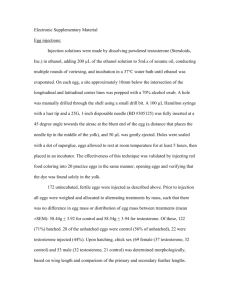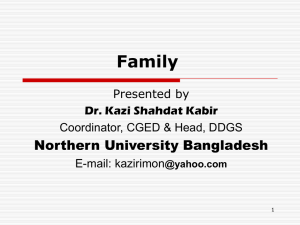Feedback - Neuroscience Fundamentals
advertisement
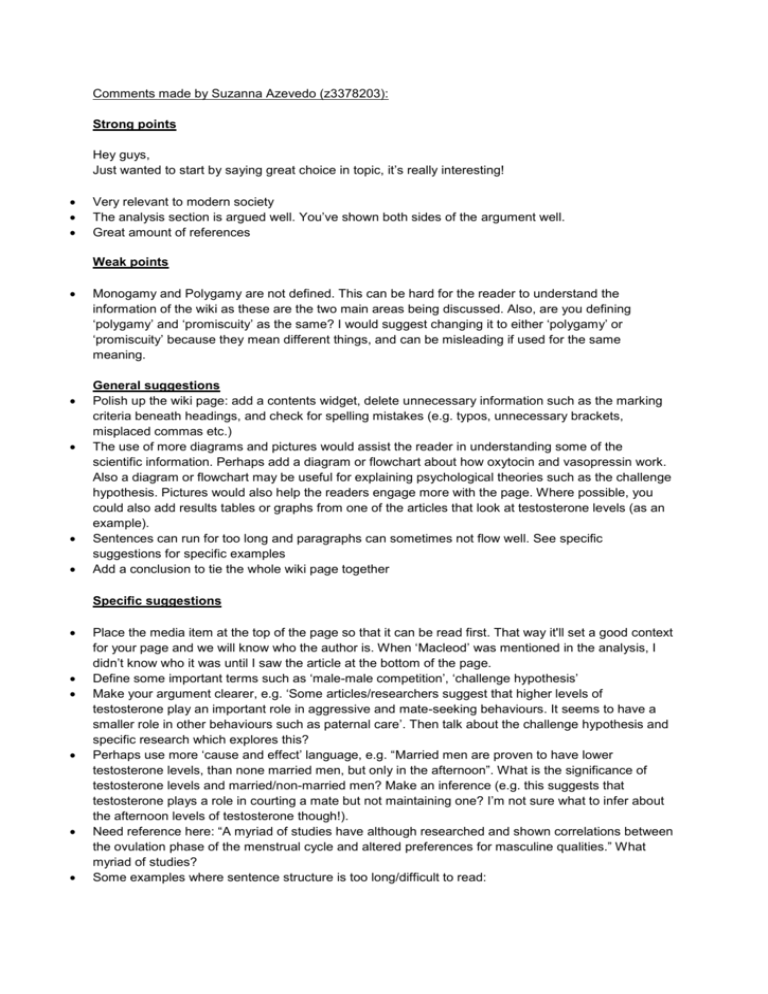
Comments made by Suzanna Azevedo (z3378203): Strong points Hey guys, Just wanted to start by saying great choice in topic, it’s really interesting! Very relevant to modern society The analysis section is argued well. You’ve shown both sides of the argument well. Great amount of references Weak points Monogamy and Polygamy are not defined. This can be hard for the reader to understand the information of the wiki as these are the two main areas being discussed. Also, are you defining ‘polygamy’ and ‘promiscuity’ as the same? I would suggest changing it to either ‘polygamy’ or ‘promiscuity’ because they mean different things, and can be misleading if used for the same meaning. General suggestions Polish up the wiki page: add a contents widget, delete unnecessary information such as the marking criteria beneath headings, and check for spelling mistakes (e.g. typos, unnecessary brackets, misplaced commas etc.) The use of more diagrams and pictures would assist the reader in understanding some of the scientific information. Perhaps add a diagram or flowchart about how oxytocin and vasopressin work. Also a diagram or flowchart may be useful for explaining psychological theories such as the challenge hypothesis. Pictures would also help the readers engage more with the page. Where possible, you could also add results tables or graphs from one of the articles that look at testosterone levels (as an example). Sentences can run for too long and paragraphs can sometimes not flow well. See specific suggestions for specific examples Add a conclusion to tie the whole wiki page together Specific suggestions Place the media item at the top of the page so that it can be read first. That way it'll set a good context for your page and we will know who the author is. When ‘Macleod’ was mentioned in the analysis, I didn’t know who it was until I saw the article at the bottom of the page. Define some important terms such as ‘male-male competition’, ‘challenge hypothesis’ Make your argument clearer, e.g. ‘Some articles/researchers suggest that higher levels of testosterone play an important role in aggressive and mate-seeking behaviours. It seems to have a smaller role in other behaviours such as paternal care’. Then talk about the challenge hypothesis and specific research which explores this? Perhaps use more ‘cause and effect’ language, e.g. “Married men are proven to have lower testosterone levels, than none married men, but only in the afternoon”. What is the significance of testosterone levels and married/non-married men? Make an inference (e.g. this suggests that testosterone plays a role in courting a mate but not maintaining one? I’m not sure what to infer about the afternoon levels of testosterone though!). Need reference here: “A myriad of studies have although researched and shown correlations between the ovulation phase of the menstrual cycle and altered preferences for masculine qualities.” What myriad of studies? Some examples where sentence structure is too long/difficult to read: o o o o o “The media item that our group has chosen to put under the neuroscience lens is an online article from the Sydney Morning Herald describing some of the physical and physiological causes underlying social promiscuity and monogamy.” Perhaps: “The media item that our group has chosen to put under the neuroscience lens is an online article from the Sydney Morning Herald. It describes some of the physical and physicological causes underlying social promiscuity and monogamy.” o The article mainly addresses neuroscience topics such as testosterone levels, female menstrual cycles, "biological messages" and genes as a means of explaining socio-sexual behaviours, so we aimed to discover not only whether their claims were valid and based in a reputable neuroscientific context, but also what other biological/neurological factors could account for these behaviours. o Therefore testosterone is not the only important hormone in play when determining levels of promiscuity and monogamy exhibited- vasopressin neurotransmission occuring in the ventral pallidum during mating is necessary for pair-pond formation and social attachment (Lim & Young, 2004). o There are more sentences that could be reworded to sound more cohesive. Hope this information helps to polish up the page. Again, well done on picking such an interesting topic! I look forward to seeing the finished product. - Suzanna Comments made by Tommy Torgersen (z3361730) Specific suggestions Make sure references are in alphabetical order. The letter “I” does not come before “G” and “H”. Move the link to the newspaper article to the top of the page so the reader can have a look at that before reading your wiki article. Remove Richard’s comment in red. Remove the instructions for each section, as it is irrelevant to the reader. Remove comma (Gray et al., 2004) under “testosterone and relationships” --> Go over in text citations. “lower testosterone levels, than none married men” --> check article for typos! I noticed a couple of them. General suggestions Maybe spice up the heading a little bit? It's a bit messy with the group members' names and such. Maybe add some more photos, diagrams, tables etc. as well? Since it's a wiki article, a table of content is often very helpful in order to give the reader a good overview. Maybe add it at the top of the page? Weak points There are two different titles – “Monogamy vs. Polygamy” and “Monogamy vs. Promiscuity”. As promiscuity and polygamy are two different things this gets quite misleading or confusing to the reader. I reckon it’s supposed to be Monogamy vs. Promiscuity because it focuses on casual sexual relations and not marriage that include more than two partners. Furthermore it would be, as already mentioned, a good idea to define the different terms. Strong points Great bibliography! Good structure over the different sections. Looks like it's written by one person instead of four, which is usually an issue with group assignments. :) Comments by z3375919: Strong points: - Good description on the first half of testosterone - Excellent and succinct section on oxytocin and vasopressin with good relation to monogamy - Introduction to testosterone and ovulation is great (makes it easy to understand when the introductions to each section ties back to the main focus) - The flow of information is very smooth with easy and understandable structure - Analysis section was done well (love the way that the references are used which flowed with the information presented) - Strong reference list Weak points: - The second paragraph explaining testosterone contained much too complicated information in regards to it which made that section confusing when reading for the first time. - The statistics given on testosterone in regards to males however interesting was not all totally directed at the topic of monogamy vs. polygamy (maybe a little sentence linking back to the main topic would increase understanding for readers – the first half seems to be more so on testosterone levels rather than monogamy and polygamy) - As mentioned by others, defining monogamy and polygamy is crucial as it is the main focus of the wikipage (maybe introduce this first before going into all the other aspects) Suggestions: - Add more visual content!! Images create another dimension in the page making it more eyecatching and easier to understand, also add a contents list so that the reader can see the direction/flow of the page - Sometimes less is more, too much scientific information can sometimes hinder the topic, the focus of monogamy and polygamy was lost when complicated information on such things as testosterone was presented - Introduce the article first by placing under the main title - this makes it easier for the reader to understand the wikipage by doing the background reading first instead of going through the page then finding the article at the end then having to try to put both pieces together backwards - Definitions make the page much easier to read and understand so when a point is made, define it first (like a mini introduction) – eg, socio-sexual questionnaire (what is it about?) - Too much statistics given in testosterone section, maybe link some that are similar together then conclude it back to monogamy and polygamy – reading too many at once loses the main focus. Overall great topic chosen, goodluck in the final submission!!
